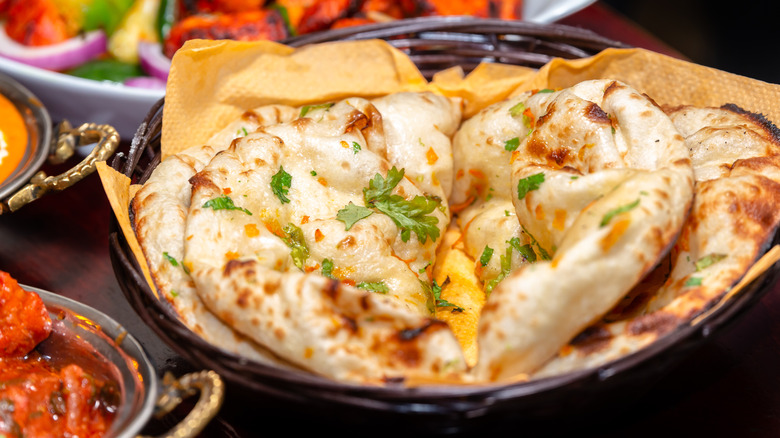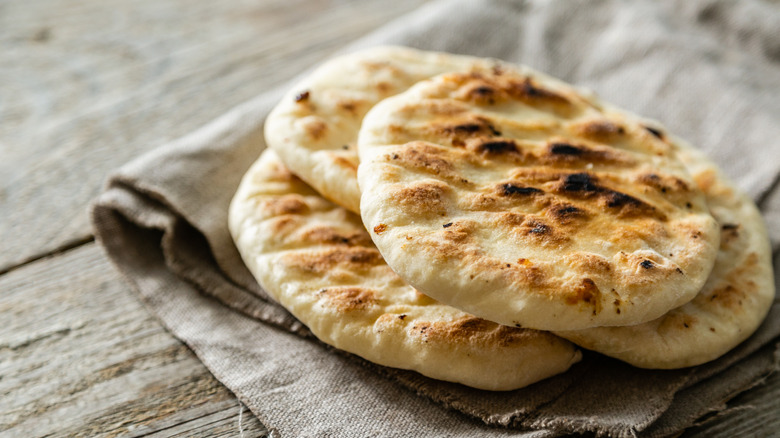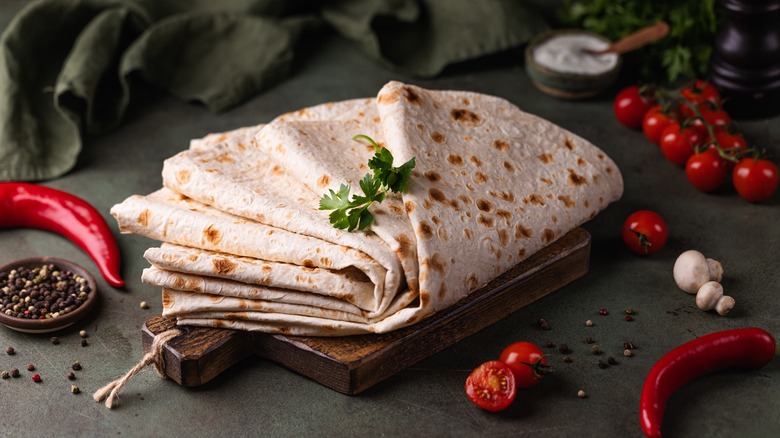The Difference Between Pita Bread And Lavash
Bread is a favorite food for most everyone. If you ask, most people's comfort food revolves around bread, whether it be a crispy grilled cheese sandwich with tomato soup or their grandma's sourdough recipe baking in the oven and filling the house with its mouth-watering aroma. The evidence that we're drawn to this culinary staple is clear since bread was made and consumed as early as 10,000 years ago, according to Grant's Bakery. There are even records that ancient civilizations in Egypt were chowing down on bread since at least the Neolithic era.
Since those (very) early days of bread making, many different kinds of breads have been invented, like potato bread, focaccia bread, and of course, flatbread. Flatbread is an iconic baked good that can be made leavened or unleavened. Bob's Red Mill says that flatbread is usually oval and topped or filled with cheeses, meats, or sauces and is incredibly common in homes worldwide. Flatbread is one of the oldest breads, and different types like pita and lavash are commonly mistaken for each other, but their origins and how they are made are pretty distinct.
What is pita bread
If you've ever had the pleasure of eating a gyro, then you've had pita bread. The chewy flatbread is typically served warm, and it is widely popular throughout several countries surrounding the Mediterranean, including Greece, Turkey, and Egypt. They are quite popular side dishes and are used to scoop up hummus, tzatziki, or any leftover salad dressing left on a plate. According to Hummus Bowls, pita bread is at least 4,000 years old and originated in the Middle East. The Greeks named the bread pita which means "flatbread," and the nomadic tribes around the area spread the concept everywhere they traveled, making it from any grains they encountered. The best part about pita (besides eating it) is that it can be made using a variety of methods including baking, steaming, frying, and grilling!
Recipe Tips claims that pita is notable for its soft texture and characteristic pocket. It is a leavened bread even though it is also considered a "flat" bread and the yeast is what helps form the inner pocket and bubbly texture. Pita is incredibly versatile and works not only as a sandwich wrap, but for dipping food, or baked into chips — much like a corn tortilla is turned into corn chips. Food Network says to use bread flour to make pita, but sites like The Mediterranean Dish use all-purpose blends so it seems like the flour you use comes down to preference.
What is lavash bread?
Lavash is also a leavened flatbread that's popular around the Mediterranean, and beyond, but according to Organic Flat Bread, lavash developed closer to the Black and Caspian Seas and was originally called tonir lavash. Only a thousand years or so younger than pita bread, lavash is traditionally baked in a tonir, which is a subterranean clay oven. Luckily, today lavash can be cooked in the oven, on a hot stove top, or griddle and is made rather simply using simple ingredients such as all-purpose flour, salt, sugar, unsalted butter, a large egg, and milk (via King Arthur Baking).
Give Recipe tells us that lavash is common in Turkish cuisine and is served alongside kebabs to make adana kebab dürüm and doner kebab wraps, or simply dipped into regional sides. Unlike pita bread, lavash can be made leavened or unleavened, based on your preference. What most distinguishes all flatbreads is their dense, toasty bite, as opposed to the soft, fluffy breads common in Western cultures.


